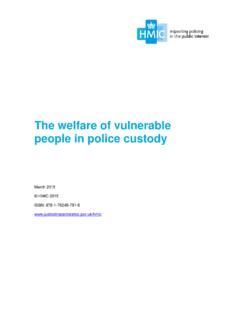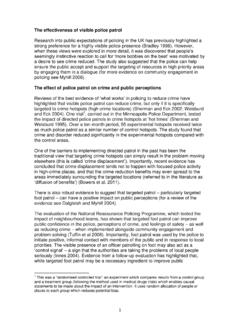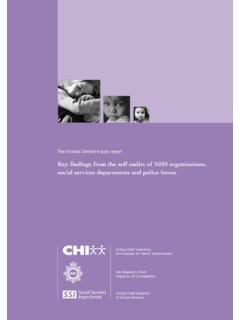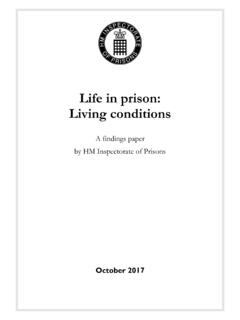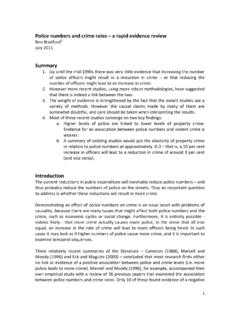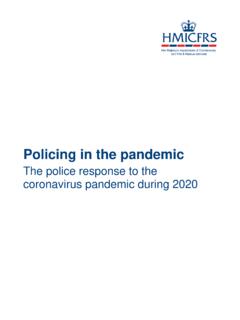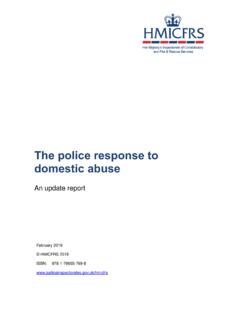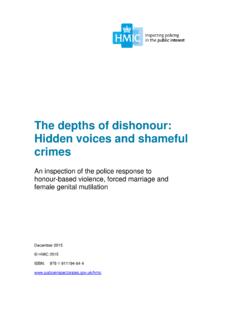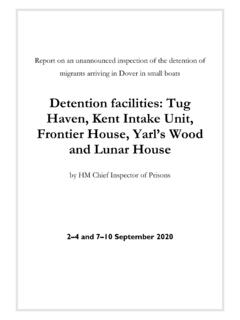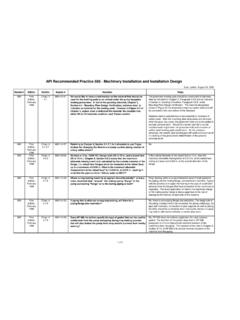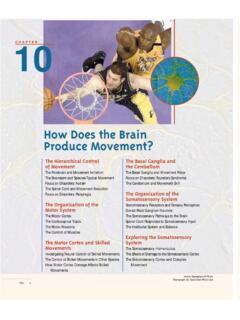Transcription of A thematic review by HM Inspectorate of Prisons
1 What happens to prisoners in a pandemic? A thematic review by HM Inspectorate of Prisons February 2021. Contents Contents Introduction 3. Section 1. Background to the report 5. Section 2. Findings 7. Section 3. Conclusion 26. Section 4. Appendices 27. Appendix I: Methodology 27. Appendix II: Contributors and acknowledgements 30. Appendix III: Glossary of terms 31. 2 What happens to prisoners in a pandemic? Introduction Introduction In April 2020, modelling conducted by HM prison and Probation Service (HMPPS) and Public Health England (PHE) suggested that over 2,000 prisoners might die as a result of COVID-19 if no action was taken to reduce contact in Prisons .
2 This was of serious concern to everyone living and working in Prisons and to their families and friends. In response to this threat, severe restrictions on daily life were imposed that had not been seen in Prisons in England and Wales for many years. At the time of writing, these restrictions had been largely effective in limiting the spread of COVID-19 in Prisons . This thematic review set out to understand the effects of the COVID-19 restrictions by speaking to women, children and men held in prison . Fieldwork consisted entirely of in-depth interviews with these women, children and men, which took place in autumn 2020 and were completed by early November.
3 We interviewed prisoners living on standard residential units who had not been able to attend work or education and had typically spent more than 22 hours a day in their cells. We spoke to men, women and children to explore differences in views. We included unconvicted prisoners, sentenced prisoners and some who were due for release. Prisoners felt that the initial lockdown rules in Prisons , imposed at the end of March 2020, were necessary. However, many months after the introduction of these restrictions, most adult prisoners were still locked in their cell for an average of hours a day, seven days a week.
4 In our interviews, prisoners questioned the legitimacy and fairness of the continuing regimes. We have heard suggestions that the restrictions, and a subsequent reduction in recorded violent incidents, have made Prisons safer. Clearly, with so little time out of cell prisoners had less opportunity to be violent or fight, but this was not the full picture according to those we interviewed. Prisoners said that violence, intimidation and bullying had not stopped, but had instead taken other forms. The accrual of debt persisted, and some had turned to using drugs as a way of managing their isolation and boredom.
5 No prisoners wanted a return to the high levels of violence seen in some Prisons before the pandemic. However, they did not believe that the answer was simply to lock people away. The challenge for HMPPS is how to manage prisoners' behaviour effectively when restrictions are eventually lifted and find ways to safely give them access to meaningful activity. As the Chief Inspector, I frequently comment on living conditions in Prisons . Cramped cells, often shared by two people, sometimes with an unscreened toilet and poor ventilation, predate the pandemic. The difference now was that prisoners who shared had virtually no privacy, while those in single cells suffered from prolonged isolation and a craving for social interaction.
6 Not having enough time to complete basic daily tasks when they were unlocked added to the pressure and frustration. During the pandemic, prisoners lacked enough day-to-day interaction and support from other prisoners, staff and their family and friends. However, the introduction of free video calling, and the continuing installation of in-cell phones, were valued by prisoners, and we look forward to seeing their continued rollout once the pandemic subsides. Some of the main functions of Prisons are to rehabilitate, reduce reoffending and help prisoners to build productive and meaningful lives.
7 Opportunities for this work had dramatically reduced due to the restrictions and prisoners we spoke to said they would be released without having had help to change their attitudes, thinking and behaviour. It is likely that prisoners who are released with no support to address their offending behaviour and no access to education or work will struggle to cope, potentially leading to further offending and greater strain on public services. We also heard What happens to prisoners in a pandemic? 3. Introduction about the anxiety experienced by unconvicted prisoners, some of whom, including children, had spent longer than a year in prison waiting for their trials.
8 The most disturbing effect of the restrictions was the decline in prisoners' emotional, psychological and physical well-being. They were chronically bored and exhausted by spending hours locked in their cells. They described being drained, depleted, lacking in purpose and sometimes resigned to their situation. Some said they were using unhealthy coping strategies, including self-harm and drugs, while others reported using mundane routines to pass the time and cope with their confinement and associated anxieties. They frequently compared themselves to caged animals. As one prisoner said: It's being imprisoned while you're in prison '.
9 During my own visits to Prisons I have seen the malaise among prisoners that is borne out so strongly in these interviews. In order to lead successful, crime-free lives when they leave custody, prisoners must change the way they feel about themselves and develop a belief that they can take control of their future. In our fieldwork we saw a sense of hopelessness and helplessness becoming engrained. The cumulative effect of such prolonged and severe restrictions on prisoners' mental health and well- being is profound. The lack of support to reduce reoffending and help prisoners address their risk of serious harm to the public does not fill me with hope for the longer term.
10 Action is needed to maintain the few positives derived from the pandemic, such as video calling, and to make sure that Prisons are prepared to restore activity as soon as it is safe. Locking prisoners up in prolonged isolation has never been a feature of a healthy prison . Charlie Taylor HM Chief Inspector of Prisons February 2021. 4 What happens to prisoners in a pandemic? Section 1. Background to the report Section 1. Background to the report Adult prisoners tend to be at greater risk from COVID-19 due to pre-existing poor health. In the last two decades, the proportion of older prisoners has increased significantly.
